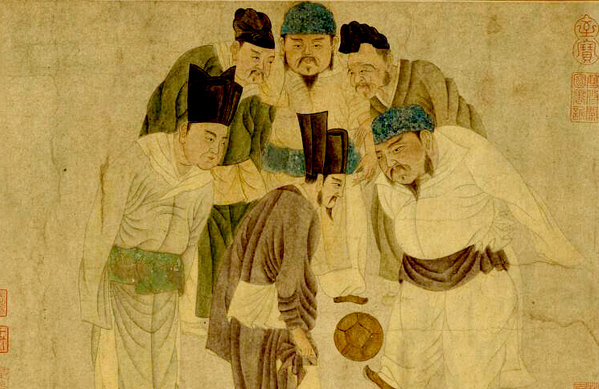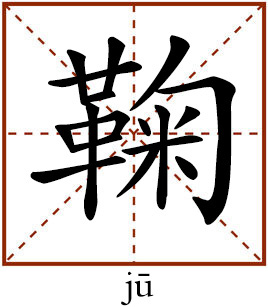Cuju paintings provide visible evidence to Chinese soccer

The painting Emperor Taizu of the Song Dynasty Plays Cuju by Qian Xuan (ILLUSTRATION 1)

Identified as the earliest form of football, Chinese cuju has a history of over 2,300 years. During its long period of evolution, cuju served both as a game for entertainment and competition as well as a sport for military training.
The word “cuju” is first seen in the Records of the Grand Historian by Sima Qian. According to the Book of Han, cuju refers to “a leather ball stuffed with fur which can be kicked for fun.” Cuju was popular in the Qi and Chu Kingdoms during the Warring States Period (453-221 BCE). Linzi, the capital of the Qi Kingdom was identified by FIFA as the “Cradle of Football” in 2004.
Cuju was used to train soldiers in the Han Dynasty and various methods of playing cuju emerged in the Tang Dynasty. Cuju became more popular in the Song Dynasty among both aristocrats and the masses alike. It became an indispensable activity during royal parties. Emperors Taizong and Huizong were themselves excellent players. Gao Qiu, a major villain of the Water Margin, one of China’s Four Great Classical Novels, caught the attention of the emperor because of his excellent cuju skills, and eventually became the minister of defense.
The enthusiasm for cuju receded in the Ming Dynasty and gradually died out in the Qing Dynasty. However, historical records on cuju have endured for over two millennia, expressed in various forms of art including paintings.
Visible evidence
Cuju is a common theme used in ancient Chinese arts including bronze mirrors, ceramics, ivory carvings and paintings. Images of cuju in various forms of arts showcased authentic scenes of this game.
For example, the painting Emperor Taizu of the Song Dynasty Plays Cuju (Illustration 1) by Su Hancheng (1094-1172) depicts Emperor Taizu, founder of the Song Dynasty, playing cuju with five senior officials. The existing copy of this painting was painted by Qian Xuan (1239-1299) in the Yuan Dynasty. Playing Cuju at the Green Garden by Ma Yuan (c.1140-c.1225) depicts five ladies playing cuju while four people stand by and watch. These ladies with different clothes had various manners and happy expressions. Through the curved tree trunks and branches, we are still able to see the footprints left behind when playing cuju.
The painting Qi People Play Cuju Game portrays seven figures. Three of them, with their right arms exposed, are focused on hitting the ball with their feet. The other four just stand by and watch. Three of the seven figures wear yellow scarfs, two, blue, and the other two, purple.
These paintings show two different forms of cuju game—with or without goals. In terms of the one with goals, each team has a captain, alternate captain and ordinary players. The two teams were differentiated from each other by the color of their uniforms, usually red or dark green. There is one goal right in the center of the playground. The goal was erected about 10 meters above the ground, which is a hole with a diameter of one-third meter on a net between two goalposts. Only the captain is entitled to shoot at the goal. When the ball goes in the hole and touches the ground before the opposing players could stop it, it can be identified as a scored goal. This form of cuju is similar to the modern football.
The other form of no-goal cuju was more similar to a modern freestyle football game. It grades the players by their movement, variety and degree of skill when playing with the ball.
Distinct characteristics
The ancient Chinese football game, which appeared a millennium before the modern football game, had its own unique characteristics.
First, players of the ancient Chinese cuju game had different social status. For example, the young man, who wears a blue hat and a red silk around his waist, in the lower-left corner of the painting by Ma Yuan (Illustration 2), is of the highest social status. One of the three players opposing him, a lady wearing a pant-skirt, binds the right button of her shirt to the left for convenience. Behind her is a maid wearing two hair buns. The other two male players wear simple clothes. They wear dark scarves and round silk fans plugged into waist belts. They are ordinary people who serve as ladder players. One of two people on the right side of the painting holds a spare ball and the old man above seems to be a servant.
The painting Emperor Taizu of the Song Dynasty Plays Cuju also indicates the unequal social status of the players. The two players are Emperor Taizu, wearing a cyan head-cloth and yellow robe on the right, and Zhao Pu on the left wearing a cyan head-cloth and purple robe. The young man behind Zhao Pu on the left is Chu Zhaofu. Those three people on the back row, from the left to the right are Shi Shouxin, Emperor Taizong, who was a younger brother of Emperor Taizu, and Dang Jin. The painting by Ma Yuan depicts the images of master, maid, ladder players and servants, reflecting the unequal status of these people and differentiating them from modern sports culture.
Secondly, the flexible application of the matching environment enriches the scenes of cuju. For example, the cuju painting by Ma Yuan shows the cuju ball being kicked high in the sky. To showcase the height of the flying ball, the entire painting was a in a portrait style where the large blank space is skillfully filled with plants such as bamboo and plum trees in the garden. The bamboo is curved by the snow in the winter and the plum tree branches also wind downward. The bamboo and plum trees, which are known as symbols of winter in Chinese culture, indicate the time and meaning of this sport. People easily caught a chill during the cold spell in spring. Typhoid fever caused by cold weather was one of diseases which were most difficult to treat in ancient China. Appropriate exercises could help take precautions against this disease. And this painting could be an evidence to the idea that playing cuju in spring warms up the body and helps prevent infections during the cold season.
In addition, the paintings properly tackled the relationship between dynamic and static things in it. For example, four of the nine figures in the painting by Ma Yuan actually participated in the sport. They open their arms, lean forward or raise their head, looking at the ball in the air. The other four people just stand by and basically watch the ball with their heads up. It demonstrates the holistic awareness within ancient China which echoes the strategic skills of modern football. If all these nine players all rush toward the ball, it would seem chaotic. This technique of painting is also seen in the painting of Emperor Taizu playing cuju. It is another example of attention paid to the harmonious relationship between dynamic and static factors while painting cuju.
Last of all, ancient paintings indicate that cuju was more of a spectator sport like gymnastics rather than a competitive sport in the spirit of modern football. The intensity of cuju, as proved by scenes on most existing cultural relics, was not as strong as a modern football game. Associating cuju with military training gradually declined after the Song Dynasty. Playing cuju became more a game about skills. The scene of a lady playing cuju is typical of this beautiful and aesthetically pleasing “game” of performance. For example, a painting on the porcelain pillow unearthed in Xingtai of Hebei Province, which can be dated back to the Song Dynasty, portrays a lady playing cuju alone.
She wears clothes with wide sleeves which are not suitable for intense sports. Her gesture is more like a dancing for entertainment. It is thus clear that cuju was primarily a sport to entertain spectators with its vivid and aesthetically pleasing gestures rather than fierce competition.
Shao Tianyi is from the College of Fine Arts at Zhejiang Normal University.
(edited by BAI LE)

 PRINT
PRINT CLOSE
CLOSE